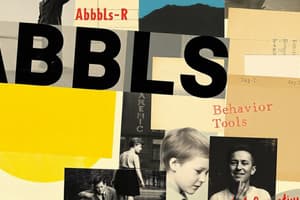Podcast
Questions and Answers
What is the primary purpose of the FISH assessment instrument?
What is the primary purpose of the FISH assessment instrument?
- To evaluate the emotional intelligence of individuals
- To measure academic performance in school subjects
- To determine goals for future educational or developmental training programs (correct)
- To assess physical fitness levels in children
Which of the following is NOT one of the seven domains organized by FISH?
Which of the following is NOT one of the seven domains organized by FISH?
- Cognitive Skills
- Speech and Language Skills
- Physical Fitness Skills (correct)
- Adaptive Behavior Skills
What benefit does FISH provide to family members and caregivers?
What benefit does FISH provide to family members and caregivers?
- Simplification of their roles in supporting the individual (correct)
- More complex strategies for emotional support
- Extended requirements for training programs
- Increased academic pressure on the individual
Which age group can benefit from the FISH program besides individuals with developmental disabilities?
Which age group can benefit from the FISH program besides individuals with developmental disabilities?
How many tasks are included in the FISH assessment series?
How many tasks are included in the FISH assessment series?
What are the Essential Eight skills in the Essential for Living assessment?
What are the Essential Eight skills in the Essential for Living assessment?
What is the primary aim of the Functional Independence Skills Handbook (FISH)?
What is the primary aim of the Functional Independence Skills Handbook (FISH)?
Which domain is NOT included in the Essential for Living skills?
Which domain is NOT included in the Essential for Living skills?
What characteristic do the skills in the Essential for Living assessment have?
What characteristic do the skills in the Essential for Living assessment have?
Which of the following best describes the population targeted by Essential for Living?
Which of the following best describes the population targeted by Essential for Living?
How many skills are included in the Essential for Living assessment?
How many skills are included in the Essential for Living assessment?
What is one of the essential goals of using instruments in special education?
What is one of the essential goals of using instruments in special education?
Which of the following is a core component of the Essential for Living assessment?
Which of the following is a core component of the Essential for Living assessment?
What is the primary purpose of the ABLLS-R?
What is the primary purpose of the ABLLS-R?
Which assessment area is NOT included in the ABLLS-R?
Which assessment area is NOT included in the ABLLS-R?
What is one benefit of using the ABLLS-R?
What is one benefit of using the ABLLS-R?
What is one purpose of the VB-MAPP?
What is one purpose of the VB-MAPP?
Which of the following is an assessment area in the ABLLS-R's Basic Learner Skills Assessment?
Which of the following is an assessment area in the ABLLS-R's Basic Learner Skills Assessment?
At what age range is the VB-MAPP primarily designed to assess children?
At what age range is the VB-MAPP primarily designed to assess children?
How many measurable learning and language milestones does the VB-MAPP contain?
How many measurable learning and language milestones does the VB-MAPP contain?
What challenge might arise when implementing the ABLLS-R?
What challenge might arise when implementing the ABLLS-R?
Which of the following skills is NOT assessed in the VB-MAPP Milestones Assessment?
Which of the following skills is NOT assessed in the VB-MAPP Milestones Assessment?
What type of assessment is the VB-MAPP primarily focused on?
What type of assessment is the VB-MAPP primarily focused on?
Which skill area does NOT fall under the Self-Help Skills Assessment in the ABLLS-R?
Which skill area does NOT fall under the Self-Help Skills Assessment in the ABLLS-R?
What does the VB-MAPP Barriers Assessment primarily focus on?
What does the VB-MAPP Barriers Assessment primarily focus on?
Which statement best describes a limitation of the ABLLS-R?
Which statement best describes a limitation of the ABLLS-R?
Which of the following is NOT one of the 24 barriers assessed by the VB-MAPP?
Which of the following is NOT one of the 24 barriers assessed by the VB-MAPP?
What is one feature of the VB-MAPP Transition Assessment?
What is one feature of the VB-MAPP Transition Assessment?
How can the results of the VB-MAPP inform educational planning?
How can the results of the VB-MAPP inform educational planning?
Which skill area focuses on tasks related to managing household activities?
Which skill area focuses on tasks related to managing household activities?
What type of skills does the School Skills domain evaluate?
What type of skills does the School Skills domain evaluate?
What is the purpose of the progress monitoring feature in the assessment?
What is the purpose of the progress monitoring feature in the assessment?
Which of the following skills is assessed under Vocational Skills?
Which of the following skills is assessed under Vocational Skills?
What does the scoring system of the AFLS indicate?
What does the scoring system of the AFLS indicate?
Which of the following best describes the Essential for Living (EFL) assessment?
Which of the following best describes the Essential for Living (EFL) assessment?
What types of skills are emphasized in the Independent Living Skills domain?
What types of skills are emphasized in the Independent Living Skills domain?
Which aspect of social skills does the AFLS evaluate?
Which aspect of social skills does the AFLS evaluate?
Which skills are assessed in Level 1 of the VB-MAPP for children aged 0–18 months?
Which skills are assessed in Level 1 of the VB-MAPP for children aged 0–18 months?
What does a score of 5 indicate in the context of VB-MAPP transitions?
What does a score of 5 indicate in the context of VB-MAPP transitions?
Which of the following is a focus area of the Assessment of Functional Living Skills (AFLS)?
Which of the following is a focus area of the Assessment of Functional Living Skills (AFLS)?
What limitation does the VB-MAPP assessment have regarding autistic students?
What limitation does the VB-MAPP assessment have regarding autistic students?
Which level of the VB-MAPP includes skills like prompted and unprompted conversation?
Which level of the VB-MAPP includes skills like prompted and unprompted conversation?
In the VB-MAPP Barriers Assessment, what does a score of 3 indicate?
In the VB-MAPP Barriers Assessment, what does a score of 3 indicate?
What is a noted challenge of the VB-MAPP assessment?
What is a noted challenge of the VB-MAPP assessment?
Which of the following does NOT fall under the key domains of the AFLS?
Which of the following does NOT fall under the key domains of the AFLS?
Flashcards
ABLLS-R Purpose
ABLLS-R Purpose
Identifying strengths and weaknesses in a child's communication and learning skills to develop targeted interventions for effective learning and language proficiency improvement.
ABLLS-R Sections
ABLLS-R Sections
Sections cover Basic Learner Skills, Academic Skills, Self-Help Skills and Motor Skills.
Basic Learner Skills
Basic Learner Skills
Assessment of skills like Cooperation, Visual Performance, Receptive Language, Imitation, Requests, Labeling and more.
Academic Skills Assessment
Academic Skills Assessment
Signup and view all the flashcards
VB-MAPP Purpose
VB-MAPP Purpose
Signup and view all the flashcards
VB-MAPP Function
VB-MAPP Function
Signup and view all the flashcards
VB-MAPP Outcomes
VB-MAPP Outcomes
Signup and view all the flashcards
Criterion Referenced assessment
Criterion Referenced assessment
Signup and view all the flashcards
VB-MAPP Milestones Assessment
VB-MAPP Milestones Assessment
Signup and view all the flashcards
VB-MAPP Barriers Assessment
VB-MAPP Barriers Assessment
Signup and view all the flashcards
Assessment of Functional Living Skills (AFLS)
Assessment of Functional Living Skills (AFLS)
Signup and view all the flashcards
AFLS Key Domains
AFLS Key Domains
Signup and view all the flashcards
VB-MAPP Skill Levels
VB-MAPP Skill Levels
Signup and view all the flashcards
VB-MAPP Challenges
VB-MAPP Challenges
Signup and view all the flashcards
Transition Skills
Transition Skills
Signup and view all the flashcards
Barriers Assessment Scores
Barriers Assessment Scores
Signup and view all the flashcards
VB-MAPP
VB-MAPP
Signup and view all the flashcards
IEP
IEP
Signup and view all the flashcards
Mand
Mand
Signup and view all the flashcards
Transition Assessment
Transition Assessment
Signup and view all the flashcards
Learning Barriers
Learning Barriers
Signup and view all the flashcards
What is the AFLS?
What is the AFLS?
Signup and view all the flashcards
What does the AFLS focus on?
What does the AFLS focus on?
Signup and view all the flashcards
What are the key features of the AFLS?
What are the key features of the AFLS?
Signup and view all the flashcards
What are some applications of the AFLS?
What are some applications of the AFLS?
Signup and view all the flashcards
What is the EFL?
What is the EFL?
Signup and view all the flashcards
Who is the EFL designed for?
Who is the EFL designed for?
Signup and view all the flashcards
What is the difference between AFLS and EFL?
What is the difference between AFLS and EFL?
Signup and view all the flashcards
Why are the AFLS and EFL important?
Why are the AFLS and EFL important?
Signup and view all the flashcards
FISH Assessment
FISH Assessment
Signup and view all the flashcards
FISH Purpose
FISH Purpose
Signup and view all the flashcards
FISH Domains
FISH Domains
Signup and view all the flashcards
AFLS Purpose
AFLS Purpose
Signup and view all the flashcards
What is Essential for Living (EFL)?
What is Essential for Living (EFL)?
Signup and view all the flashcards
What are the Essential Eight skills?
What are the Essential Eight skills?
Signup and view all the flashcards
What is the Functional Independence Skills Handbook (FISH)?
What is the Functional Independence Skills Handbook (FISH)?
Signup and view all the flashcards
What is the purpose of FISH?
What is the purpose of FISH?
Signup and view all the flashcards
What are the Skill Focus Areas in EFL?
What are the Skill Focus Areas in EFL?
Signup and view all the flashcards
How are EFL skills sequenced?
How are EFL skills sequenced?
Signup and view all the flashcards
What is the purpose of the Essential Eight?
What is the purpose of the Essential Eight?
Signup and view all the flashcards
What is a criterion-referenced assessment?
What is a criterion-referenced assessment?
Signup and view all the flashcards
Study Notes
Week 13 Assessments
- Week 13 assessments cover various tools for evaluating language and learning proficiency in children.
Assessment of Basic Language and Learning Skills-Revised (ABLLS-R)
- A comprehensive tool for evaluating children's language and learning proficiency.
- Criterion-referenced assessment based on observation of child's skills.
- Ages: birth to 12 years.
Purpose of ABLLS-R
- Identify a child's strengths and weaknesses in communication and learning.
- Develop targeted interventions to promote effective learning and enhance language proficiency based on identified skills.
- The tool aids in understanding a child's current skills.
Section 1: Basic Learner Skills Assessment
- Includes areas like cooperation, visual performance, receptive language, imitation, vocal imitation, requests, labeling, intraverbals, spontaneous vocalizations, syntax and grammar, play, social interaction, group instruction, following classroom routines, and generalized responding.
Section 2: Academic Skills Assessment
- Includes areas like reading, math, writing, and spelling skills.
Section 3: Self-Help Skills
- Includes areas like dressing, eating, grooming, and toileting skills.
Section 4: Motor Skills Assessment
- Includes areas like gross motor and fine motor skills.
Assessment of Basic Language and Learning Skills-Revised (ABLLS-R) Skill Tracking System
- Educational purposes only.
- This section appears as a table with specific skills/areas tracked and assessed.
Benefits of Using ABLLS-R
- Establishes clear baseline data.
- Tracks progress over time.
- Facilitates individualized education plans (IEPs).
- Empowers educators to tailor strategies to meet individual needs.
Challenges of Using ABLLS-R
- Time constraints.
- Need for training.
- Potential biases in assessment.
- Addressing these challenges is key to maximizing the tool's effectiveness.
Purpose of VB-MAPP
- Evaluate language, learning, and social skills of children with autism and other developmental disabilities.
- Assess current skills, identifying barriers to progress.
- Analyze needs, guide curriculum development.
- Track growth over time.
- Guide individualized education program (IEP) development.
VB-MAPP Milestones Assessment
- Criterion-referenced assessment.
- Ages 0-4, but can be used with language delays at any age.
- Provides a representative sample of a child's current verbal and related skills.
- Contains 170 measurable milestones across three developmental levels (0-18 months, 18-30 months, and 30-48 months).
- Assesses skills in various areas including mand, tact, echoic, intraverbal, listener, motor imitation, independent play, social and social play, visual perception, matching, linguistic structure, group and classroom skills, and early academics.
- Includes the Early Echoic Skills Assessment (EESA) subtest.
VB-MAPP Barriers Assessment
- Assesses 24 common learning and language acquisition barriers in children with autism or other developmental disabilities.
- Identifies specific problems to develop targeted interventions.
VB-MAPP Transition Assessment
- Assesses 18 areas to determine if a child is making progress.
- Provides a measurable way for the IEP team to set priorities and meet the child's educational needs.
- Includes various summary measures and additional transition-related skills.
Milestones Level 1, 2, and 3
- Level 1 (0-18 months): Assesses skills like requesting, labeling, visual perception, matching, and independent play.
- Level 2 (18-30 months): Adds skills like prompted and unprompted conversation, classroom routines, and linguistic structure.
- Level 3 (30-48 months): Includes reading, writing, and mathematics skills.
Barriers Assessment
- Scores of 3 or 4 indicate persistent or severe problems, while 2 or 1 indicate moderate or occasional problems.
Assessment of Functional Living Skills (AFLS)
- Completed by parents, educators, or therapists using observations, interviews, and task performance.
- Includes a progress-tracking grid and teaching guidance.
- Ages 2 years and up.
Purpose of AFLS
- Assess and teach essential skills for independent living.
- Includes practical real-world skills across various settings.
Key Domains of AFLS
- Basic Living Skills (personal care, hygiene, safety, maintaining a clean living environment)
- Home Skills (household management)
- Community Participation Skills (public transportation, shopping, interactions)
- School Skills (schoolwork, listening, following directions)
- Vocational Skills (employment readiness)
- Independent Living Skills (meal prep, money management, emergency situations)
- Social Skills (conversation, social rules, relationships)
Features of AFLS
- Individualized assessment
- Scoring system (level system for skill performance)
- Progress monitoring (tracking over time)
- Practical approach (emphasizes transition to adulthood)
Resources for Purchasing Assessments
- Provides links to purchase assessments (ABLLS-R, VB-MAPP, AFLS, EFL)
Grading Rubric
- Criteria for evaluating a project including the assessment, completion, and accuracy of results. Includes sections on assessment report completion, accuracy of results, and writing quality and formatting.
Essential for Living Assessment (EFL)
- Curriculum-based assessment instrument.
- Designed for children and adults with moderate to severe disabilities.
- Includes core components covering areas like communication, language, daily living, social skills, functional academics, and tolerance of situations, skills are sequenced from must-have to nice-to-have.
- Utilizes the Essential Eight.
- Used with IEPs, ISPs, program plans, and behavior improvement plans.
Functional Independence Skills Handbook (FISH)
- Material for determining a person's ability to perform daily living tasks.
- Assessment tool, and curriculum, with lesson plans for specific tasks.
- Suitable for people with developmental disabilities across the lifespan.
- Organized by seven domains: Adaptive Behavior, Affective, Cognitive, Sensorimotor, Social, Speech and Language, and Vocational Skills.
Challenges of VB-MAPP
- Time needed for administration.
- Skill level of the assessor.
- Potential for mis-representation of autistic needs by comparing autistic individuals to neurotypical norms.
Studying That Suits You
Use AI to generate personalized quizzes and flashcards to suit your learning preferences.




